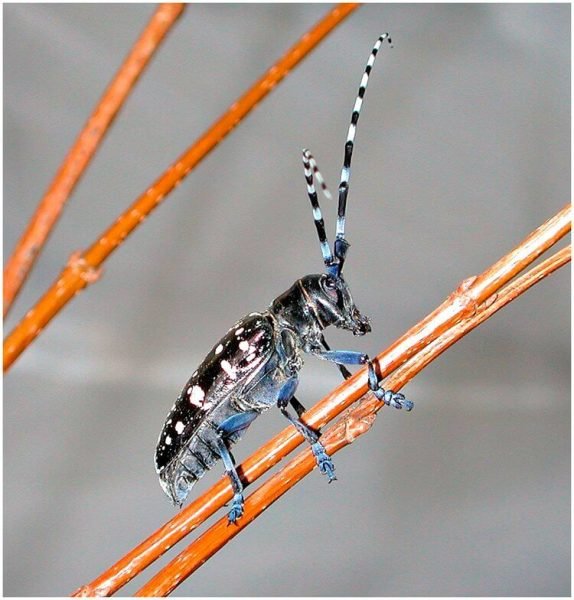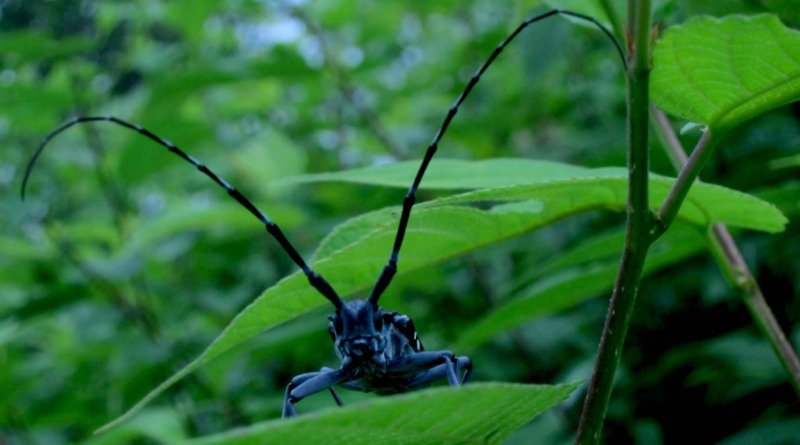Asian Longhorned Beetle – Deadly Beauty
I love my trees and I have always been in awe of their beauty in parks and in the fields and forested areas here in Ohio where I live. But once again, we need to be watching for infestations of another pest, the Asian Longhorned Beetle.
August is the month where adult ALB activity is at its peak and you should report any activity you may find to the USDA Animal and Plant Health Inspection Services.
Personally, we have had damage to trees in our yard from the Emerald Ash Borer, losing 13 trees to that invasive pest. And I don’t want to lose even more hardwoods from infestations of the ALB.
The Asian Longhorned Beetle (Anoplophora glabripennis) is native to parts of Asia, and it is believed to have arrived in North America in wooden pallets or packing material used to ship cargo from China. Infestations were discovered back in 1996 in Brooklyn and Amityville, New York, and in Chicago, Illinois. Other invaded areas have been found in Massachusetts, New Jersey, and Ohio. In all instances where Asian Longhorned Beetles have been found, authorities reacted quickly to stop the spread. It was eradicated in Hudson County, New Jersey and Illinois. Visit this USDA APHIS site to see what pests may be a threat in your state.

Unfortunately, in most instances, eradication is accomplished by destroying infected trees. The wood is put through chipper/shredders and disposed of, grinding up the larvae hidden deep in the tree. One of the ways to prevent the spread is by using firewood only from your local area and not transporting it in from other localities, or taking it out to other areas. Most recent bulletin update: Aug 3, 2021 USDA Animal and Plant Health Inspection Service

The trees most targeted by the Asian Longhorned Beetle are the maples, but infestations have also been found in willows, elms, mulberries, horse chestnuts, poplars and black locusts. Currently, there is no known chemical or biological defense against the Asian Longhorned Beetle and, in North America, they have few natural predators. In all cases of infestation, the affected trees are cut down and the wood destroyed. The destruction of our trees not only affects the beauty of our cities and towns, animal habitats, urban ecosystems, even the air we breathe, but also affects industries that depend on timber. Even our local Sugar Maple industry here in Ohio could not happen if all our sugar maples would succumb to the ALB.
Battle With The Asian Longhorned Beetle
Once a tree is infested, there is no reliable or sure cure. Our best defense against the beetle is to have as many people as possible looking for and reporting signs of infestation.
You may notice unseasonable yellow leaves or drooping leaves on your trees occurring when there is not a drought condition. Beetles leave a deep and perfectly round hole as its exit from a tree. These holes may ooze sap. You may also notice what is called “frass” which is the insect’s waste and sawdust around a tree’s base or stuck on the trunk or forks of branches. Egg deposits leave round dimpled areas on a tree trunk.
If you should see signs in your trees, it is necessary to report these to allow officials to verify if it is ALB. A property owner here in Ohio reported an infestation discovered on his property in Clermont county, resulting in a quarantine covering 61 square miles. By April 2015, there had been 65,300 infested and vulnerable trees removed and another 26,300 trees had been treated with pesticides. ( Ref: Ohio Asian longhorned beetle cooperative eradication program Media Update April 23, 2015)

The ALB is almost a pretty insect. It is shiny black with white spots and can be up to one and one-half inches long with antennae longer than its body. Its six long legs appear to be blue. They can fly in short bursts with a loud buzzing noise and you might find them on trees, plants, or even on your lawn furniture, sidewalks or cars. Catch one and put it in a jar to show to officials. It is so important to locate these insects, so if you should see one, report it immediately.

To report signs or symptoms of ALB, please call the Ohio Survey Program toll free at (855) 252-6450. For more information for your state, please visit: www.aphis.usda.gov and www.agri.ohio.gov.
Photo credit: Featured Image
By Sulayman3990 – Own work, CC BY-SA 4.0, https://commons.wikimedia.org/w/index.php?curid=34704424



Thanks, I’ll keep an eye out!
Oh no! It is so sad when a pest comes that isn’t native to the area. Thank you for sharing, though! Education is important when dealing with pests!